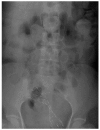Interventional management of malignant colorectal obstruction: use of covered and uncovered stents
- PMID: 17277564
- PMCID: PMC2626692
- DOI: 10.3348/kjr.2007.8.1.57
Interventional management of malignant colorectal obstruction: use of covered and uncovered stents
Abstract
Objective: We wanted to evaluate usefulness of uncovered stent in comparison with covered stent for the palliative treatment of malignant colorectal obstruction.
Materials and methods: Covered (n = 52, type 1 and type 2) and uncovered (n = 22, type 3) stents were placed in 74 patients with malignant colorectal obstruction. Stent insertion was performed for palliative treatment in 37 patients (covered stent: n = 23 and uncovered stent: n = 14). In the palliative group, the data on the success of the procedure, the stent patency and the complications between the two groups (covered versus uncovered stents) were compared.
Results: The technical success rate was 89% (33/37). Symptomatic improvement was achieved in 86% (18/21) of the covered stent group and in 92% (11/12) of the uncovered stent group patients. The period of follow-up ranged from three to 319 days (mean period: 116+/-85 days). The mean period of stent patency was 157+/-33 days in the covered stent group and 165+/-25 days in the uncovered stent group. In the covered stent group, stent migration (n = 11), stent fracture (n = 2) and poor expansion of the stent (n = 2) were noted. In the uncovered stent group, tumor ingrowth into the stents (n = 3) was noted.
Conclusion: Self-expanding metallic stents are effective for relieving malignant colorectal obstruction. The rate of complications is lower in the uncovered stent group than in the covered stent group.
Figures




Similar articles
-
The efficacy of metallic stent placement in the treatment of colorectal obstruction.Korean J Radiol. 2002 Apr-Jun;3(2):79-86. doi: 10.3348/kjr.2002.3.2.79. Korean J Radiol. 2002. PMID: 12087197 Free PMC article.
-
Comparison of uncovered stent with covered stent for treatment of malignant colorectal obstruction.Gastrointest Endosc. 2007 Nov;66(5):931-6. doi: 10.1016/j.gie.2007.02.064. Epub 2007 Sep 4. Gastrointest Endosc. 2007. PMID: 17767930 Clinical Trial.
-
Favorable long-term clinical outcome of uncovered D-weave stent placement as definitive palliative treatment for malignant colorectal obstruction.Dis Colon Rectum. 2012 Sep;55(9):983-9. doi: 10.1097/DCR.0b013e31825c484d. Dis Colon Rectum. 2012. PMID: 22874606
-
Uncovered versus covered stent in management of large bowel obstruction due to colorectal malignancy: a systematic review and meta-analysis.Int J Colorectal Dis. 2019 May;34(5):773-785. doi: 10.1007/s00384-019-03277-3. Epub 2019 Mar 23. Int J Colorectal Dis. 2019. PMID: 30903271
-
Expandable metal stent placement for malignant colorectal obstruction.Endoscopy. 2002 Oct;34(10):823-30. doi: 10.1055/s-2002-34271. Endoscopy. 2002. PMID: 12244506 Review. No abstract available.
Cited by
-
Evidence-based recommendations on colorectal stenting: a report from the stent study group of the korean society of gastrointestinal endoscopy.Clin Endosc. 2013 Jul;46(4):355-67. doi: 10.5946/ce.2013.46.4.355. Epub 2013 Jul 31. Clin Endosc. 2013. PMID: 23964332 Free PMC article.
-
A study of lymph node ratio in stage IV colorectal cancer.World J Surg Oncol. 2008 Dec 1;6:127. doi: 10.1186/1477-7819-6-127. World J Surg Oncol. 2008. PMID: 19046414 Free PMC article.
-
Self-Expanding Metal Stents as an Alternative to Palliative Surgery in Advanced Obstructive Colorectal Cancer-A Systematic Review and Meta-Analysis.J Clin Med. 2025 Jun 18;14(12):4339. doi: 10.3390/jcm14124339. J Clin Med. 2025. PMID: 40566085 Free PMC article. Review.
-
Palliative procedures for advanced obstructive colorectal cancer: a systematic review and meta-analysis.Int J Colorectal Dis. 2024 Sep 23;39(1):148. doi: 10.1007/s00384-024-04724-6. Int J Colorectal Dis. 2024. PMID: 39311995 Free PMC article.
-
Clinical outcomes and patency of self-expanding metal stents in patients with malignant colorectal obstruction: a prospective single center study.Int J Colorectal Dis. 2008 Aug;23(8):789-94. doi: 10.1007/s00384-008-0477-1. Epub 2008 Apr 29. Int J Colorectal Dis. 2008. PMID: 18443807
References
-
- Nugent KP, Daniels P, Stewart B, Patankar R, Johnson CD. Quality of life in stoma patients. Dis Colon Rectum. 1999;42:1569–1574. - PubMed
-
- Stone JM, Bloom RJ. Transendoscopic balloon dilatation of complete colonic obstruction. An adjunct in the treatment of colorectal cancer: report of three cases. Dis Colon Rectum. 1989;32:429–431. - PubMed
-
- Spinelli P, Mancini A, Dal Fante M. Endoscopic treatment of gastrointestinal tumors: indications and results of laser photocoagulation and photodynamic therapy. Semin Surg Oncol. 1995;11:307–318. - PubMed
-
- Hoekstra HJ, Verschueren RC, Oldhoff J, van der Ploeg E. Palliative and curative electrocoagulation for rectal cancer. Cancer. 1985;55:210–213. - PubMed
-
- Davids PH, Groen AK, Rauws EA, Tytgat GN, Huibregtse K. Randomised trial of self-expanding metal stents versus polyethylene stents for distal malignant biliary obstruction. Lancet. 1992;340:1488–1492. - PubMed
MeSH terms
LinkOut - more resources
Full Text Sources
Medical

